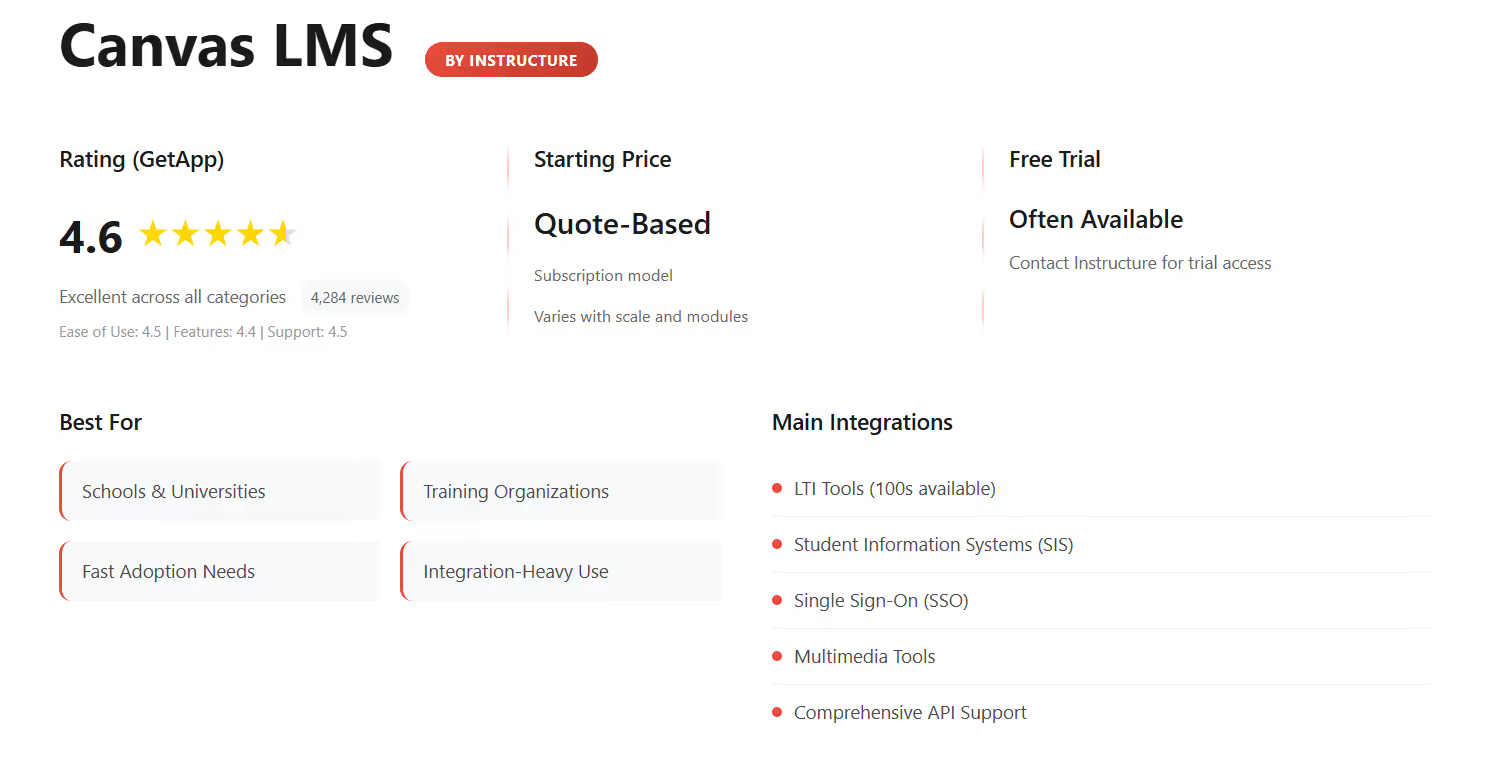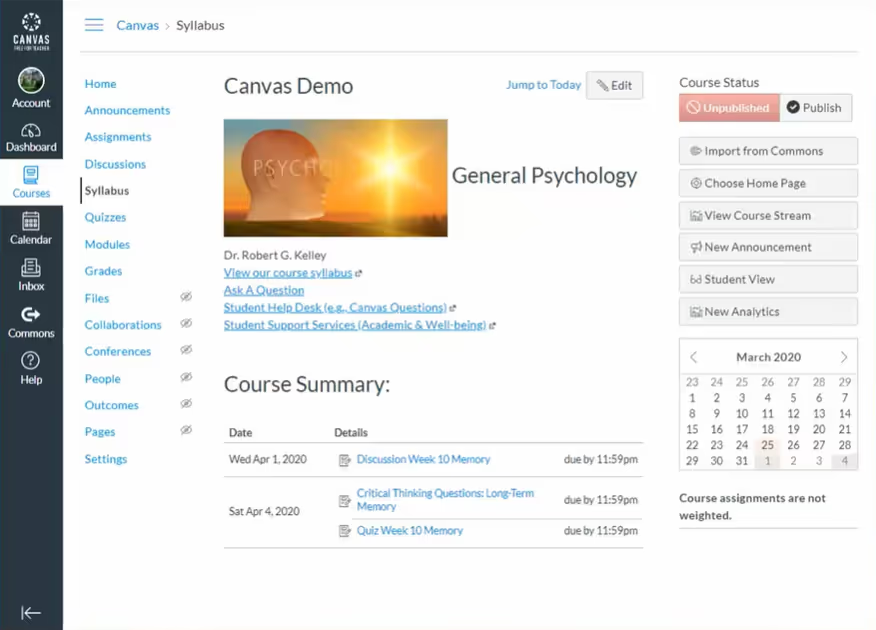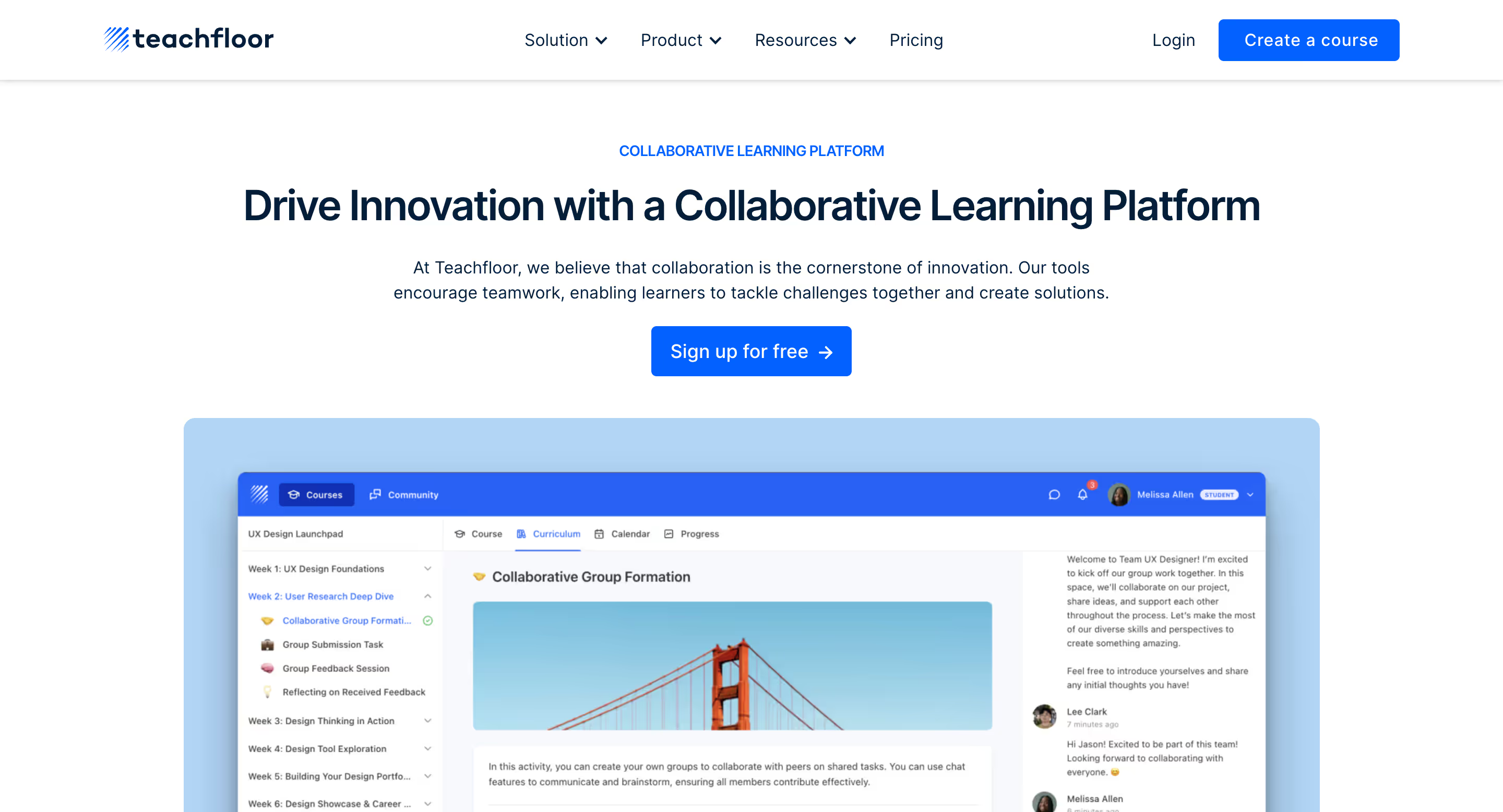If you’ve been exploring learning management systems and keep running into D2L vs Canvas, you’re definitely not the only one. These two platforms show up in just about every comparison or shortlist discussion. To clear things up, D2L is the company behind Brightspace, while Canvas is the platform created by Instructure. Both are well-established, widely used, and constantly evolving with new features around analytics and AI.
The real question isn’t which one is more popular, but which one actually fits the way your organization teaches and learns. Do you need something highly customizable and data-driven, or something simple and quick for your team to pick up?
In this guide, we’ll go through both platforms in plain, straightforward language so you can see how they really work, where they shine, where they might fall short, and what’s new in 2025 that could help you decide which one is the better fit for your school, university, or business.
How D2L and Canvas Stack Up
Let’s take a closer look at D2L vs Canvas, exploring how each platform approaches learning management and where they deliver the most value.
Inside D2L Brightspace

D2L Brightspace is an enterprise-grade LMS built for organizations that prioritize data-driven learning, scalability, and customization. It’s designed for higher education, government, and large corporate environments, combining adaptive learning paths with advanced analytics that track engagement and predict outcomes.
Brightspace integrates smoothly with Microsoft Teams, Salesforce, and Zoom, offering flexibility across complex ecosystems. However, it usually requires structured onboarding and technical support to get the most out of its capabilities.
Where It Shines and Where It Struggles
Brightspace excels in analytics, accessibility, and customization, making it perfect for data-focused institutions. Its main challenges are a steeper learning curve, longer setup, and higher costs compared to plug-and-play LMS options.
Inside Canvas

Canvas by Instructure is a cloud-based LMS known for simplicity, usability, and open integrations. It’s widely used across K–12, higher education, and online programs thanks to its clean interface, mobile apps, and large integration ecosystem. Canvas is quick to deploy and easy for educators to learn, requiring minimal IT involvement.
Where It Shines and Where It Struggles
Canvas stands out for its intuitive design, active community, and strong integration support. Its limitations lie in reduced deep customization and lighter analytics compared to Brightspace, which can make it less flexible for large-scale enterprise use.
D2L vs Canvas: Ease of use and setup
Let’s talk first impressions. If you hand Canvas to a new instructor, most folks can poke around and get moving with minimal coaching. The design is intentionally straightforward, you can drag items into Modules, and SpeedGrader keeps grading in one view. The community documentation is deep and written for busy instructors.

Brightspace is also approachable, but it gives admins and instructional designers a lot more knobs to turn. That is great once you know what you want, and it does mean more setup decisions up front. D2L’s documentation is detailed and they push monthly improvements that often touch security, data, or authoring.
In 2025 they added things like email based 2FA and continued AI expansion. Those are real benefits, yet they also mean your admins should watch release notes and plan enablement.
Highlight: Canvas gets new faculty productive fast. Brightspace rewards teams that want control and can invest a little more in configuration and onboarding.
D2L vs Canvas: Course creation and content management
When it comes to building and managing courses, both D2L Brightspace and Canvas give educators what they need, just in different ways.
Brightspace is all about structure and flexibility. Teachers can design adaptive learning paths that adjust to each student’s progress, upload SCORM or xAPI packages, and organize lessons in a very detailed way. It’s a great fit for schools or training programs that care about data and want to track learning outcomes closely. The setup can take a little longer, but once everything is in place, it’s incredibly powerful for managing complex programs.

Canvas keeps things simple and fast. Its modules view helps teachers stay organized, the rich content editor makes lesson creation easy, and SpeedGrader is a favorite among educators because it lets them grade assignments, use rubrics, and leave comments or video feedback all in one spot. Teachers often say it feels effortless to set up a course and keep it running smoothly throughout the semester.
Both platforms do the essentials very well. The choice really comes down to what matters most to your teaching style. If you want deep customization and adaptive learning tools, Brightspace gives you that control. If you prefer a clean, user-friendly platform that saves time on setup and grading, Canvas is the way to go.
Highlight: If you need adaptive learning paths and deep package handling, Brightspace is a comfortable home. If you want fast course build and grading that feels smooth, Canvas is hard to beat.
D2L vs Canvas: Assessment and grading
SpeedGrader is one of Canvas’s crown jewels. You open an assignment, move student to student, apply a rubric, annotate files, drop in a short video comment, and publish. It is all right there. SpeedGrader documentation and campus guides are everywhere, which helps faculty pick it up quickly.
Brightspace’s assignments and quizzes are robust, with detailed settings for attempts, accommodations, and release conditions. Monthly releases often tweak assessment details, and D2L’s newer Lumi Pro features include AI assisted feedback and answer-level suggestions for quiz items, which can reduce authoring time.
Highlight: SpeedGrader is a daily quality-of-life win for Canvas instructors. Brightspace is steadily adding AI assisted assessment authoring and feedback that can save setup time and improve consistency.
D2L vs Canvas: Learning analytics and reporting
This is where Brightspace has an edge for many institutions. D2L’s Insights Dashboards and analytics builder are designed to move beyond simple participation counts. You can create custom reports from Brightspace Data Sets and visualize progress, engagement, and risk so advisers or corporate managers can act earlier. D2L continues to update Data Hub and the Insights layer.
Canvas analytics are clear and useful for instructors. You can see participation, grades, and activity without extra training. The company is also investing in accessibility and usability improvements that make everyday analysis easier to digest for mainstream faculty. Still, if your analytics team wants a built-out BI surface inside the LMS, Brightspace is the stronger out-of-the-box pick today.
Highlight: If you want dashboards, custom reporting, and data sets ready to interrogate, Brightspace is a great fit. If you want simple course-level analytics that help instructors keep a finger on the pulse, Canvas does that cleanly.
D2L vs Canvas: Integrations, standards, and ecosystem
Both products support modern interoperability standards, which matters a lot if you have a big stack.
Canvas supports LTI 1.3 and LTI Advantage, with admin tools to create developer keys for tool configuration. There is a huge integration ecosystem and many third parties document their Canvas LTI steps explicitly.
Brightspace supports LTI Advantage v1.3, plus SCORM and xAPI package workflows right in Content. D2L’s IntegrationHub and SCORM guides make those connections straightforward for admins.
If your content team is SCORM heavy and you want first class controls in the LMS, Brightspace is friendly to that. If your pedagogy leans on a constellation of apps and you want the widest set of LTI tools that instructors can add with minimal friction, Canvas usually feels more open.
Highlight: Both play nicely with standards. Canvas often wins on breadth of LTI integrations. Brightspace often wins on depth for packaged content control.
D2L vs Canvas: Mobile experience
Mobile is not a side dish anymore. Students expect to check grades, post a discussion reply, or submit something from a phone.
Canvas Student app: Students can submit assignments, take quizzes, send and receive messages, and keep up with a To Do list. Instructure maintains native iOS and Android apps for Students, Teachers, and Parents, and the app store listings underscore how fully featured the student app is today.
Brightspace Pulse centralizes calendars, due dates, grades, and announcements. It does a nice job of helping learners plan their week. Some institutions advise that high-stakes quizzes are best on desktop, and some embedded tools may open in a mobile browser. D2L’s own knowledge base sets expectations clearly.
Highlight: Canvas leans into full course participation in the mobile app. Brightspace Pulse excels at helping learners track workload and stay on top of upcoming tasks.
D2L vs Canvas: Security and compliance
Everyone asks about this. Both vendors run on AWS and both maintain formal security programs.
The Trust Center outlines security practices and compliance, including SOC assessments and ISO controls, plus platform security patterns in AWS. Specific product attestations like SOC 2 for Catalog and ISO for Impact are publicly announced. Customers can request compliance packages for deeper review.
D2L documents ISO 27001 certification and privacy program details, and describes how Brightspace is secured on AWS. D2L also calls out support for SSO and local authentication controls so customers can align Brightspace to their identity strategy.
Highlight: Both meet modern enterprise expectations. If your security team wants to see controls, you will be able to review Trust Center materials and formal attestations from either vendor.
D2L vs Canvas: AI features and roadmap signals
This is a big 2025 topic. Both companies are investing.
In Brightspace AI, monthly notes show Lumi Chat, Lumi Tutor, and AI assisted answer-level feedback and outcome alignment. These are opt-in features, and some are part of Lumi Pro that may require add-on licensing.
Wheras in Canvas, Instructure announced a high profile partnership to bring OpenAI capabilities into Canvas, including LLM enabled assignments and teacher assistants that fit into classroom workflows. This signals more embedded AI for planning, feedback, and analytics inside Canvas.
Highlight: Brightspace is threading AI into assessment design and learner support. Canvas is threading AI into assignments, teacher workflows, and platform experiences. If AI is a core part of your roadmap, ask each vendor how their guardrails and data controls align with your policies.
Pricing approach and value signals
Neither vendor shares a public price list for their LMS. Both provide quotes based on your organization’s size, feature requirements, and support level, which is standard for enterprise LMS deals. D2L’s community discussions confirm that pricing goes through their sales team, and schools often ask about user caps or licensing tiers. Canvas works in a similar way, with pricing tailored to your enrollment and selected modules.
Here’s some practical advice:
- Smaller schools often find Canvas easier to plan and roll out since its default setup needs minimal configuration.
- Larger universities, statewide systems, or global companies usually see Brightspace (D2L)’s analytics, branding, and scalability as worth the extra planning.
Highlight: Treat pricing as a total cost of ownership conversation. Include onboarding time, admin headcount, training services, data needs, and support tier in your model.
Who Each Platform Fits Best
When it comes to where each platform truly excels, D2L Brightspace is right at home in large, structured environments that need scale and precision. It’s a top choice for universities running multi-language programs, complex courses, and detailed reporting. Corporate and government training teams also benefit from its strong compliance tracking and data analytics. Brightspace is ideal for organizations that want full control over branding and navigation, creating a learning experience that feels uniquely their own.
Canvas, meanwhile, is a natural fit for schools and districts that want a platform that just works right out of the box. Its clean interface, intuitive design, and massive integration marketplace make it a favorite for K–12 and higher education institutions that value quick adoption and minimal setup. Educators can build courses, grade assignments, and collaborate with ease, all without heavy IT involvement.
Highlight: Both platforms serve different needs. Brightspace fits institutions focused on scale and data, while Canvas appeals to those who want simplicity and speed. Your priorities will point you to the right choice.
Alternatives to consider: Teachfloor

If you appreciate the powerful, data-driven side of D2L Brightspace but wish it were easier to use, or if you enjoy the simplicity of Canvas but want more flexibility, Teachfloor offers the best of both worlds. It provides the kind of enterprise-level functionality that large organizations rely on, yet it stays simple, quick to set up, and budget friendly.
Teachfloor is made for modern teams such as educators, training providers, and growing organizations that want a platform capable of handling serious training programs without the usual technical hurdles. You can design and manage courses, run live or self-paced sessions, automate enrollments, and build branded learning spaces with just a few clicks. The interface is intuitive, the workflows make sense, and you never feel buried in complexity.
Key Features That Set Teachfloor Apart
- AI-powered course builder for instant course outlines
- Cohort-based and self-paced learning modes
- Built-in community and peer discussion spaces
- Multi-branch management for clients, teams, or departments
- Native SCORM upload and built-in SCORM converters
- Custom white-label branding and domain setup
- Automation for enrollment, tagging, and learner workflows
- Course landing page generator for instant publishing
- Integrated live classes with Zoom, Google Meet, and Microsoft Teams
- Secure payment processing with Stripe integration
- Centralized analytics and progress tracking dashboard
- Built-in certificates and completion tracking
What makes Teachfloor stand out is how naturally it balances sophistication and ease of use. It delivers the structure and analytics you would expect from D2L along with the clean experience and flexibility that Canvas users love. The result is a platform that feels powerful, approachable, and ready to grow with you.
Verdict: D2L vs Canvas (2025)
Both D2L Brightspace and Canvas are great learning platforms, but they suit different needs. D2L works best for teams that care about data, analytics, and full control over how learning is delivered. It’s powerful, detailed, and built for organizations that need a system that can grow with them.
Canvas is the better choice if you want something that’s easy to use, quick to set up, and simple for teachers and students to navigate. It focuses on giving users a smooth experience without a lot of extra steps or technical work.
If you’re looking for something that combines the best parts of both, Teachfloor is worth considering. It brings together the structure and depth of D2L with the clean, user-friendly feel of Canvas, giving you a balanced platform that’s powerful yet easy to manage.
%201.svg)
.avif)

.png)
.avif)
%20(28).avif)
.avif)
.avif)


%201.svg)

